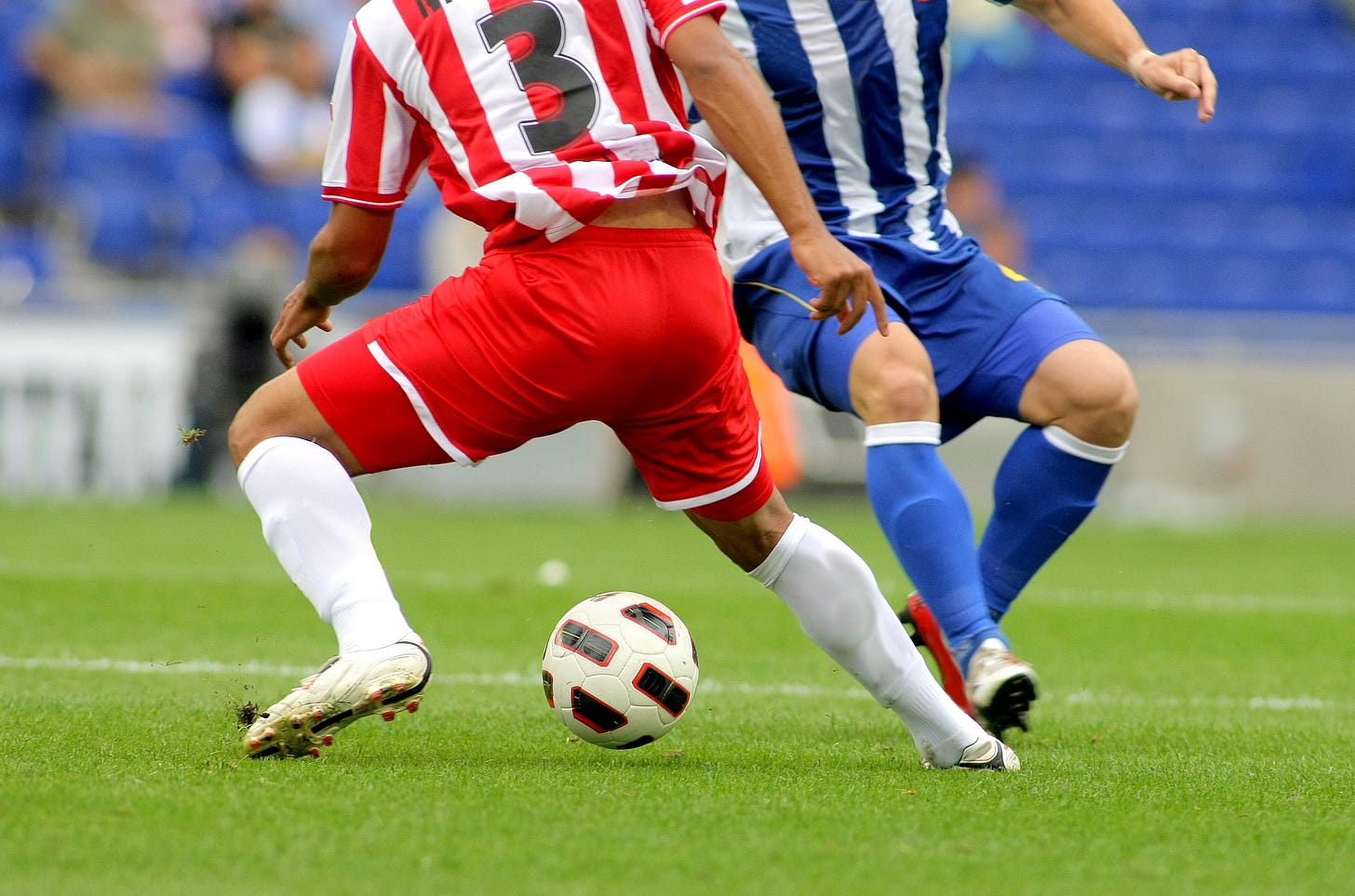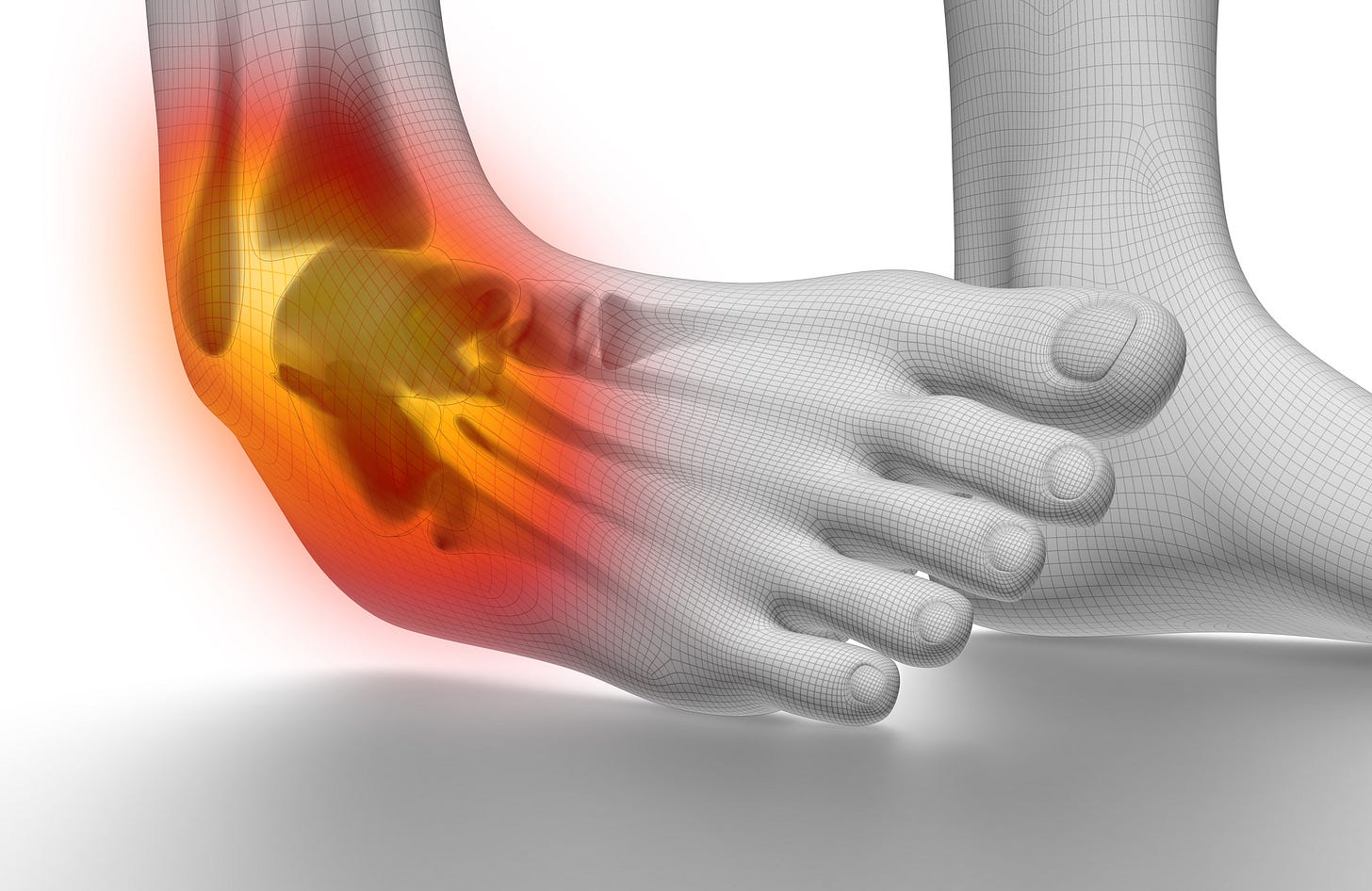Before we discuss the complementary pair of the heel and the anus, let’s recap setting the ankle.
You set the ankle when the tibia pitches (the shin rotates forwards or backwards) and the heel yaws (rotates in or out). This creates a 2D rotation that propels you forward.
The tibialis muscles and the peroneal muscles (Ts and Ps) work together to create the ankle movement that facilitates this 2D action.
The tibialis muscles connect to the big toe side of the ankle. The peroneal muscles connect to the pinkie toe side of the ankle.
This 2D rotation of tibia pitch and heel yaw that occurs when you set the ankle creates a foundation that translates to balance and motion.
The quicker the ankle sets, the quicker the movement, which is convenient for whatever it is you are trying to do because, balance.
Setting the ankle also gives you control over things like what direction you move and the weight shift that occurs.
Heel yaw, tibia pitch on the left leg of the athlete in red and the left leg of the athlete in blue. Heel yaw on the right side for the athlete in red and the athlete in blue.
Setting the ankle is not the same thing as ankle inversion or eversion, terms that are used to describe the lateral movement of the rear foot or heel. When you excessively invert your ankle, you put a lot of pressure or strain on the structures that limit the amount of movement at the ankle joint. This stretches the ligaments and can cause an ankle sprain.
Ankle inversion
If the goal is performance or injury prevention, training positions with the ankle in a lot of inversion places the ankle in a vulnerable position, one that won’t make it easy to shift weight quickly.
A lot of ankle eversion, on the other hand, pulls the medial longitudinal arch towards the ground. Since the arch isn’t supposed to be on the ground (the nature of an arch is that it lifts away from the ground), training the foot in positions that place the ankle in a lot of eversion isn’t going to translate to fast, integrated movement either.
The foot is your foundation. The ankle controls the position of the foot. When the heel yaws in, setting the ankle, it ensures a smooth weight shift.
“Jenn, you keep talking about using the heel, but you have given me no guidance for how to do that,” you might be thinking.
You can yaw the heel of the foot on the ground or you can yaw the heel of the foot on the ground by pulling the heel towards the anus.
When the foot is off the ground, pulling the heel towards the anus sets up the foot for a good landing position. When it is on the ground, it automatically creates contraction of the Ps and Ts.
Another way to think of this is when the foot is off the ground in an open position, pulling the heel towards the anus creates the space needed to move forward.
When the foot is on the ground in a closed position, pulling the heel towards the anus sets up the weight shift.
The answer to why this works lies in rotations. When the foot is off the ground and you pull the heel towards the anus, what allows this to happen?
The femur and the pelvis. This creates a backwards circle, a rotation that brings the body forward and keeps you in balance.
This circle is balanced by the relationship of the heel and the anus. What happens if instead of pulling the heel towards the anus you pull the heel towards the outside of the hip?
Your circle becomes wobbly. The rotations will shift so that you can maintain a semblance of balance.
You can see this concept in action when you watch the slow motion clip of Eliud Kipchoge, in white, in the video below. (The slow motion part starts at 1:10.) His heel rotates in (yaws in) when it’s on the ground; as the leg swings behind, the heel moves towards the anus (yawing in).
When Simone Biles sets up for the round off at the 17 second marker, the heels are rotated in. The heels yawing in sets up the weight shift she needs to rotate in space.
You can also see when you watch Simone Biles that whether the heels rotate in or not depends on the task. She doesn’t rotate the heels in for every skill that she performs—only when it makes sense for either weight shift or to set up the next rotation. What she does do is set her ankles for every task. This means ankle set and heels in can go together. But they don’t have to.
Try this:
The next time you set up for a single leg squat, consciously think about pulling the closed foot heel towards your anus before you begin your squat. Consciously think about pulling the open foot heel towards your anus as you squat.
How does that change the single leg squat?
You can learn more about this April 24-28 in the Netherlands with Dawn Ross, Adarian Barr, and me. Come for one day or come for all of the days. I promise it will be a learning and movement extravaganza.
Warmly,
Jenn








Hello! That is correct. You don't always need to yaw the heel in to get the ankle set. If you are having trouble setting the ankle, the heel yaw can help. Does that make sense?
Hi. I am a bit confused here. Ankle set is tibial pitch and heel yaw, but sometimes no need to yaw in?